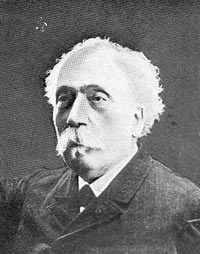
Édouard Benjamin Baillaud was a French astronomer.

The ketogenic diet is a high-fat, adequate-protein, low-carbohydrate dietary therapy that in conventional medicine is used mainly to treat hard-to-control (refractory) epilepsy in children. The diet forces the body to burn fats rather than carbohydrates.

Pierre Adolphe Piorry was a French physician born in Poitiers. He invented pleximetry and was the creator of medical terms toxin, toxemia and septicemia.
Gargando is a small town located in the Tombouctou Region of Mali. The people are mainly from subdivisions of the Kel Ansar tribe. The village has many educated Touareg people.

The Diocese of Périgueux and Sarlat is a Latin Church ecclesiastical territory or diocese of the Catholic Church in France. Its episcopal see is Périgueux, in the département of Dordogne, in the région of Aquitaine. The Diocese of Périgueux is a suffragan diocese in the ecclesiastical province of the metropolitan Archdiocese of Bordeaux. The current bishop is Philippe Mousset, who was appointed in 2014.
The Recueil des historiens des croisades is a major collection of several thousand medieval documents written during the Crusades. The documents were collected and published in Paris in the 19th century, and include documents in Latin, Greek, Arabic, Old French, and Armenian. The documents cover the entire period of the Crusades, and are frequently cited in scholarly works, as a way of locating a specific document. When being quoted in citations, the collection is often abbreviated as RHC or R.H.C..

Jacques Raphaël Lépine was a French physiologist who was a native of Lyon.

The Autonomous Province of Korçë, sometimes referred to as Republic of Korçë, was an autonomous legal entity established in 27/10 December 1916, by the local French forces after the city of Korçë fell under their control during World War I, and which lasted until 1920.

Paul-Jean-Louis Azan was a French general and author. He is remembered for his missions to the United States during World War I and his French historical and military writings which examined and celebrated French Colonial rule in North Africa.

François Gabriel Théodore Basset de Jolimont was a French artist, lithographer, painter and antiquary.
Jean Guillaume Roquille was a French tinsmith and poet who wrote in the Franco-Provençal language. Some of his work was burlesque, but much was serious commentary on the wretched conditions of the working people in the industrial regions of the Saint-Étienne basin and Lyon.

Guillaume-Charles Faipoult was a French aristocrat, soldier and politician who was Minister of Finance during the French Revolution. He then represented France in Italy, where he organized the newly formed republics. During the First French Empire he was prefect of the Scheldt department, and then Minister of Finance in Spain under Joseph Bonaparte. Faipoult was prefect of Saône-et-Loire during the Hundred Days.
Jean-Baptiste-Louis-Théodore de Tschudi also known as Tschoudi or Tschudy was a French botanist and poet.
Jacques-Guillaume Legrand was a French architect and critic.
Henri Hitier was a French agronomist.
Michel Etienne Anthelme Théodore Grandperret was a French lawyer and politician. He was a staunch Bonapartist. He served briefly as Minister of Justice and Religious Affairs during the last weeks on the Second French Empire. Later he was a Life Senator from 1877 to his death.

Ernest Nyssens was a Belgian homeopath, naturopath, theosophist and vegetarianism activist.

Émile Arthur Vallin was a French military physician, considered to be a precursor of public health in France a convinced Pasteurian.

Charles Louis Xavier Arnozan was a French physician, professor of therapeutics then of medical clinic at the Faculty of Medicine of Bordeaux, member of the Académie Nationale de Médecine, deputy mayor of Bordeaux in charge of hygiene.

Baron Alban Emmanuel Guillaume-Rey was a French archaeologist, topographer and orientalist. He is known for his historical works on Crusader states and on military fortifications in the Near East. He is considered by some as the first archeologists of the Crusades.
This page is based on this
Wikipedia article Text is available under the
CC BY-SA 4.0 license; additional terms may apply.
Images, videos and audio are available under their respective licenses.













